Evidence for liquid water during the high-density to low-density amorphous ice transition
- PMID: 19258453
- PMCID: PMC2660733
- DOI: 10.1073/pnas.0812481106
Evidence for liquid water during the high-density to low-density amorphous ice transition
Abstract
Polymorphism of water has been extensively studied, but controversy still exists over the phase transition between high-density amorphous (HDA) and low-density amorphous (LDA) ice. We report the phase behavior of HDA ice inside high-pressure cryocooled protein crystals. Using X-ray diffraction, we demonstrate that the intermediate states in the temperature range from 80 to 170 K can be reconstructed as a linear combination of HDA and LDA ice, suggesting a first-order transition. We found evidence for a liquid state of water during the ice transition based on the protein crystallographic data. These observations open the possibility that the HDA ice induced by high-pressure cryocooling is a genuine glassy form of high-density liquid.
Conflict of interest statement
The authors declare no conflict of interest.
Figures




References
-
- Angell CA. In: Water: A Comprehensive Treatise. Franks F, editor. Vol 7. New York: Plenum; 1982. pp. 1–81.
-
- Debenedetti PG, Stanley HE. Supercooled and glassy water. Phys Today. 2003;56:40–46.
-
- Debenedetti PG. Supercooled and glassy water. J Phys Condens Matter. 2003;15:R1669–R1726.
-
- Speedy RJ. Stability-limit conjecture. An interpretation of the properties of water. J Phys Chem. 1982;86:982–991.
-
- Stanley HE, Teixeira J. Interpretation of the unusual behavior of H2O and D2O at low temperatures: Tests of a percolation model. J Chem Phys. 1980;73:3404–3422.
Publication types
Grants and funding
LinkOut - more resources
Full Text Sources

